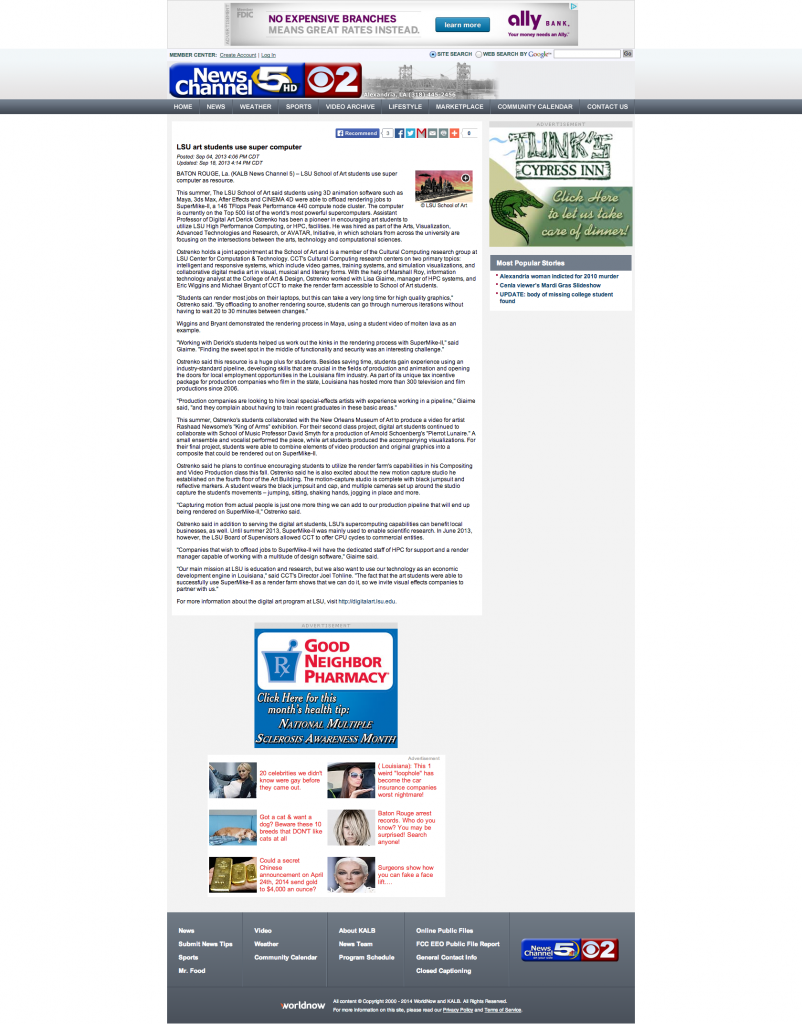LSU art students use super computer
Posted: Sep 04, 2013 4:06 PM CDTUpdated: Sep 18, 2013 4:14 PM CDT
BATON ROUGE, La. (KALB News Channel 5) – LSU School of Art students use super computer as resource.
This summer, The LSU School of Art said students using 3D animation software such as Maya, 3ds Max, After Effects and CINEMA 4D were able to offload rendering jobs to SuperMike-II, a 146 TFlops Peak Performance 440 compute node cluster. The computer is currently on the Top 500 list of the world's most powerful supercomputers. Assistant Professor of Digital Art Derick Ostrenko has been a pioneer in encouraging art students to utilize LSU High Performance Computing, or HPC, facilities. He was hired as part of the Arts, Visualization, Advanced Technologies and Research, or AVATAR, Initiative, in which scholars from across the university are focusing on the intersections between the arts, technology and computational sciences.
Ostrenko holds a joint appointment at the School of Art and is a member of the Cultural Computing research group at LSU Center for Computation & Technology. CCT's Cultural Computing research centers on two primary topics: intelligent and responsive systems, which include video games, training systems, and simulation visualizations, and collaborative digital media art in visual, musical and literary forms. With the help of Marshall Roy, information technology analyst at the College of Art & Design, Ostrenko worked with Lisa Giaime, manager of HPC systems, and Eric Wiggins and Michael Bryant of CCT to make the render farm accessible to School of Art students.
"Students can render most jobs on their laptops, but this can take a very long time for high quality graphics," Ostrenko said. "By offloading to another rendering source, students can go through numerous iterations without having to wait 20 to 30 minutes between changes."
Wiggins and Bryant demonstrated the rendering process in Maya, using a student video of molten lava as an example.
"Working with Derick's students helped us work out the kinks in the rendering process with SuperMike-II," said Giaime. "Finding the sweet spot in the middle of functionality and security was an interesting challenge."
Ostrenko said this resource is a huge plus for students. Besides saving time, students gain experience using an industry-standard pipeline, developing skills that are crucial in the fields of production and animation and opening the doors for local employment opportunities in the Louisiana film industry. As part of its unique tax incentive package for production companies who film in the state, Louisiana has hosted more than 300 television and film productions since 2006.
"Production companies are looking to hire local special-effects artists with experience working in a pipeline," Giaime said, "and they complain about having to train recent graduates in these basic areas."
This summer, Ostrenko's students collaborated with the New Orleans Museum of Art to produce a video for artist Rashaad Newsome's "King of Arms" exhibition. For their second class project, digital art students continued to collaborate with School of Music Professor David Smyth for a production of Arnold Schoenberg's "Pierrot Lunaire." A small ensemble and vocalist performed the piece, while art students produced the accompanying visualizations. For their final project, students were able to combine elements of video production and original graphics into a composite that could be rendered out on SuperMike-II.
Ostrenko said he plans to continue encouraging students to utilize the render farm's capabilities in his Compositing and Video Production class this fall. Ostrenko said he is also excited about the new motion capture studio he established on the fourth floor of the Art Building. The motion-capture studio is complete with black jumpsuit and reflective markers. A student wears the black jumpsuit and cap, and multiple cameras set up around the studio capture the student's movements – jumping, sitting, shaking hands, jogging in place and more.
"Capturing motion from actual people is just one more thing we can add to our production pipeline that will end up being rendered on SuperMike-II," Ostrenko said.
Ostrenko said in addition to serving the digital art students, LSU's supercomputing capabilities can benefit local businesses, as well. Until summer 2013, SuperMike-II was mainly used to enable scientific research. In June 2013, however, the LSU Board of Supervisors allowed CCT to offer CPU cycles to commercial entities.
"Companies that wish to offload jobs to SuperMike-II will have the dedicated staff of HPC for support and a render manager capable of working with a multitude of design software," Giaime said.
"Our main mission at LSU is education and research, but we also want to use our technology as an economic development engine in Louisiana," said CCT's Director Joel Tohline. "The fact that the art students were able to successfully use SuperMike-II as a render farm shows that we can do it, so we invite visual effects companies to partner with us."
For more information about the digital art program at LSU, visit http://digitalart.lsu.edu.


